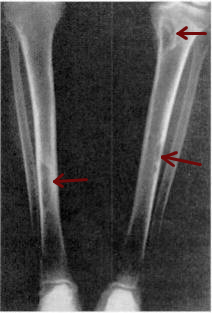Osteitis fibrosa cystica
(Redirected from Brown tumor)
Editor-In-Chief: Prab R Tumpati, MD
Obesity, Sleep & Internal medicine
Founder, WikiMD Wellnesspedia &
W8MD medical weight loss NYC and sleep center NYC
| Osteitis fibrosa cystica | |
|---|---|

| |
| Synonyms | Von Recklinghausen's disease of bone |
| Pronounce | N/A |
| Specialty | N/A |
| Symptoms | Bone pain, fractures, skeletal deformities |
| Complications | Hypercalcemia, kidney stones, osteoporosis |
| Onset | Typically in adults |
| Duration | Chronic |
| Types | N/A |
| Causes | Hyperparathyroidism |
| Risks | Parathyroid adenoma, parathyroid hyperplasia |
| Diagnosis | Blood test, X-ray, bone scan |
| Differential diagnosis | Osteoporosis, Paget's disease of bone |
| Prevention | N/A |
| Treatment | Parathyroidectomy, bisphosphonates |
| Medication | Calcimimetics, vitamin D |
| Prognosis | Good with treatment |
| Frequency | Rare |
| Deaths | N/A |
Other names[edit | edit source]
Osteitis fibrosa cystica; Hyperparathyroidism - osteitis fibrosa; Brown tumor of bone
Definition[edit | edit source]
Osteitis fibrosa is a condition of bones when they become abnormally weak and deformed due to a complication of hyperparathyroidism.
Parathyroid glands[edit | edit source]
The parathyroid glands are 4 tiny glands in the neck. These glands produce parathyroid hormone (PTH). PTH helps control calcium, phosphorus, and vitamin D levels in the blood and is important for healthy bones.
Causes[edit | edit source]
Excessive parathyroid hormone (hyperparathyroidism) can lead to increased bone breakdown, which can cause bones to become weaker and more fragile.
Osteoporosis[edit | edit source]
Many people with hyperparathyroidism eventually develop osteoporosis.
Pathophysiology[edit | edit source]
- Not all bones respond to PTH in the same way.
- Some develop abnormal areas where the bone is very soft and has almost no calcium in it and this is osteitis fibrosa.
- In rare cases, parathyroid cancer causes osteitis fibrosa.
- Osteitis fibrosa is now very rare in people who have hyperparathyroidism who have good access to medical care.
- It is more common in people who develop hyperparathyroidism at a young age, or who have untreated hyperparathyroidism for a long time.
Symptoms[edit | edit source]
Osteitis fibrosa may cause bone pain or tenderness. There may be fractures (breaks) in the arms, legs, or spine, or other bone problems. Hyperparathyroidism itself may cause any of the following:
- Nausea
- Constipation
- Fatigue
- Frequent urination
- Weakness
Management[edit | edit source]
- Investigations include blood tests show a high level of calcium, parathyroid hormone, and alkaline phosphatase (a bone chemical).
- Phosphorus level in the blood may be low.
- X-rays may show thin bones, fractures, bowing, and cysts.
- Teeth x-rays may also be abnormal.
- A bone x-ray may be done.
- People with hyperparathyroidism are more likely to have osteopenia (thin bones) or osteoporosis (very thin bones) than to have full-blown osteitis fibrosa.
Treatment[edit | edit source]
Most of the bone problems from osteitis fibrosa can be reversed with surgery to remove the abnormal parathyroid gland(s). Some people may choose not to have surgery, and instead be followed with blood tests and bone measurements. If surgery is not possible, medicines can sometimes be used to lower calcium level.
Complications[edit | edit source]
Complications of osteitis fibrosa include any of the following:
- Bone fractures
- Deformities of bone
- Pain
- Problems due to hyperparathyroidism, such as kidney stones and kidney failure
Prevention[edit | edit source]
Routine blood tests done during a medical checkup or for another health problem usually detect a high calcium level before severe damage is done.
| This article is a medical stub. You can help WikiMD by expanding it! | |
|---|---|
| Parathyroid disease | ||||||
|---|---|---|---|---|---|---|
|
| Bone and joint disease | ||||||||||||||||||||
|---|---|---|---|---|---|---|---|---|---|---|---|---|---|---|---|---|---|---|---|---|
|
Search WikiMD
Ad.Tired of being Overweight? Try W8MD's physician weight loss program.
Semaglutide (Ozempic / Wegovy and Tirzepatide (Mounjaro / Zepbound) available.
Advertise on WikiMD
|
WikiMD's Wellness Encyclopedia |
| Let Food Be Thy Medicine Medicine Thy Food - Hippocrates |
Translate this page: - East Asian
中文,
日本,
한국어,
South Asian
हिन्दी,
தமிழ்,
తెలుగు,
Urdu,
ಕನ್ನಡ,
Southeast Asian
Indonesian,
Vietnamese,
Thai,
မြန်မာဘာသာ,
বাংলা
European
español,
Deutsch,
français,
Greek,
português do Brasil,
polski,
română,
русский,
Nederlands,
norsk,
svenska,
suomi,
Italian
Middle Eastern & African
عربى,
Turkish,
Persian,
Hebrew,
Afrikaans,
isiZulu,
Kiswahili,
Other
Bulgarian,
Hungarian,
Czech,
Swedish,
മലയാളം,
मराठी,
ਪੰਜਾਬੀ,
ગુજરાતી,
Portuguese,
Ukrainian
Medical Disclaimer: WikiMD is not a substitute for professional medical advice. The information on WikiMD is provided as an information resource only, may be incorrect, outdated or misleading, and is not to be used or relied on for any diagnostic or treatment purposes. Please consult your health care provider before making any healthcare decisions or for guidance about a specific medical condition. WikiMD expressly disclaims responsibility, and shall have no liability, for any damages, loss, injury, or liability whatsoever suffered as a result of your reliance on the information contained in this site. By visiting this site you agree to the foregoing terms and conditions, which may from time to time be changed or supplemented by WikiMD. If you do not agree to the foregoing terms and conditions, you should not enter or use this site. See full disclaimer.
Credits:Most images are courtesy of Wikimedia commons, and templates, categories Wikipedia, licensed under CC BY SA or similar.
Contributors: Prab R. Tumpati, MD


